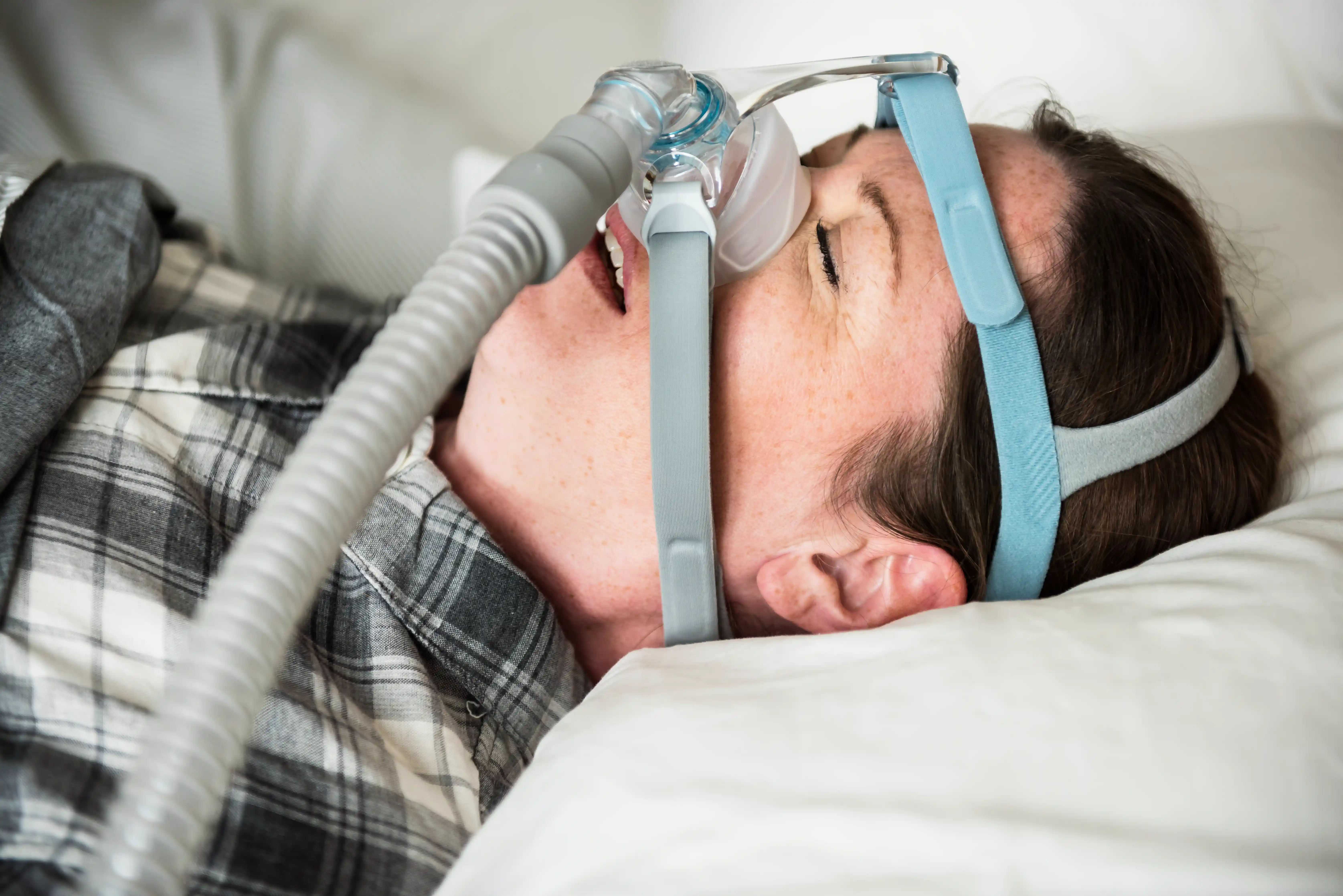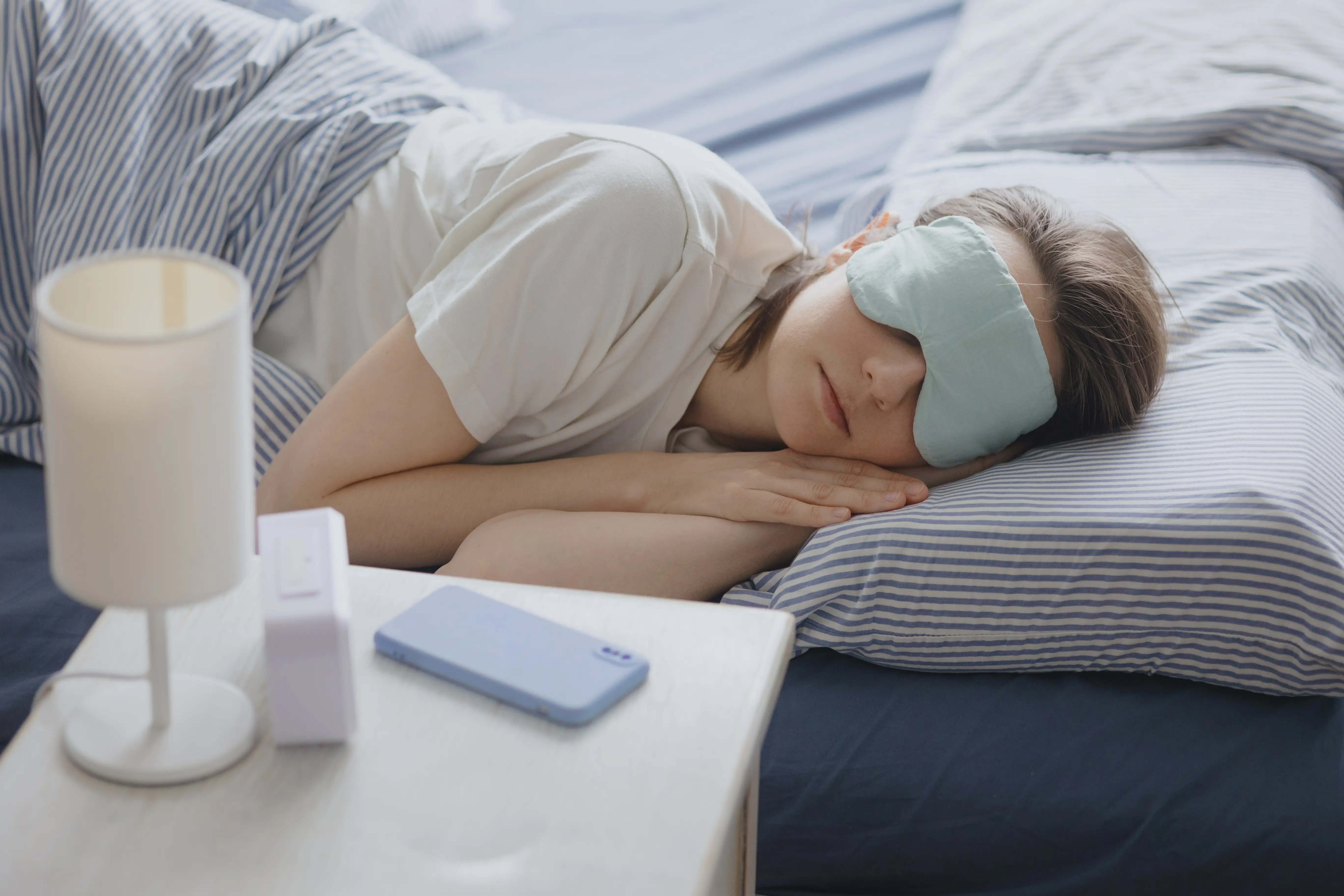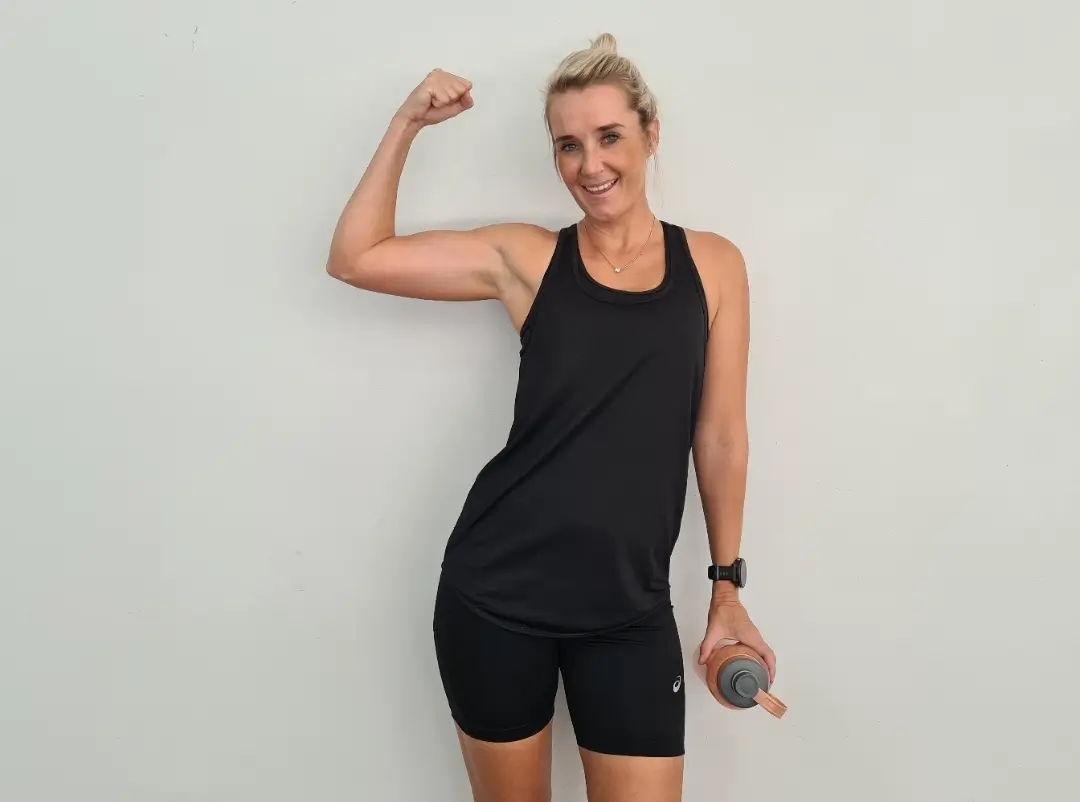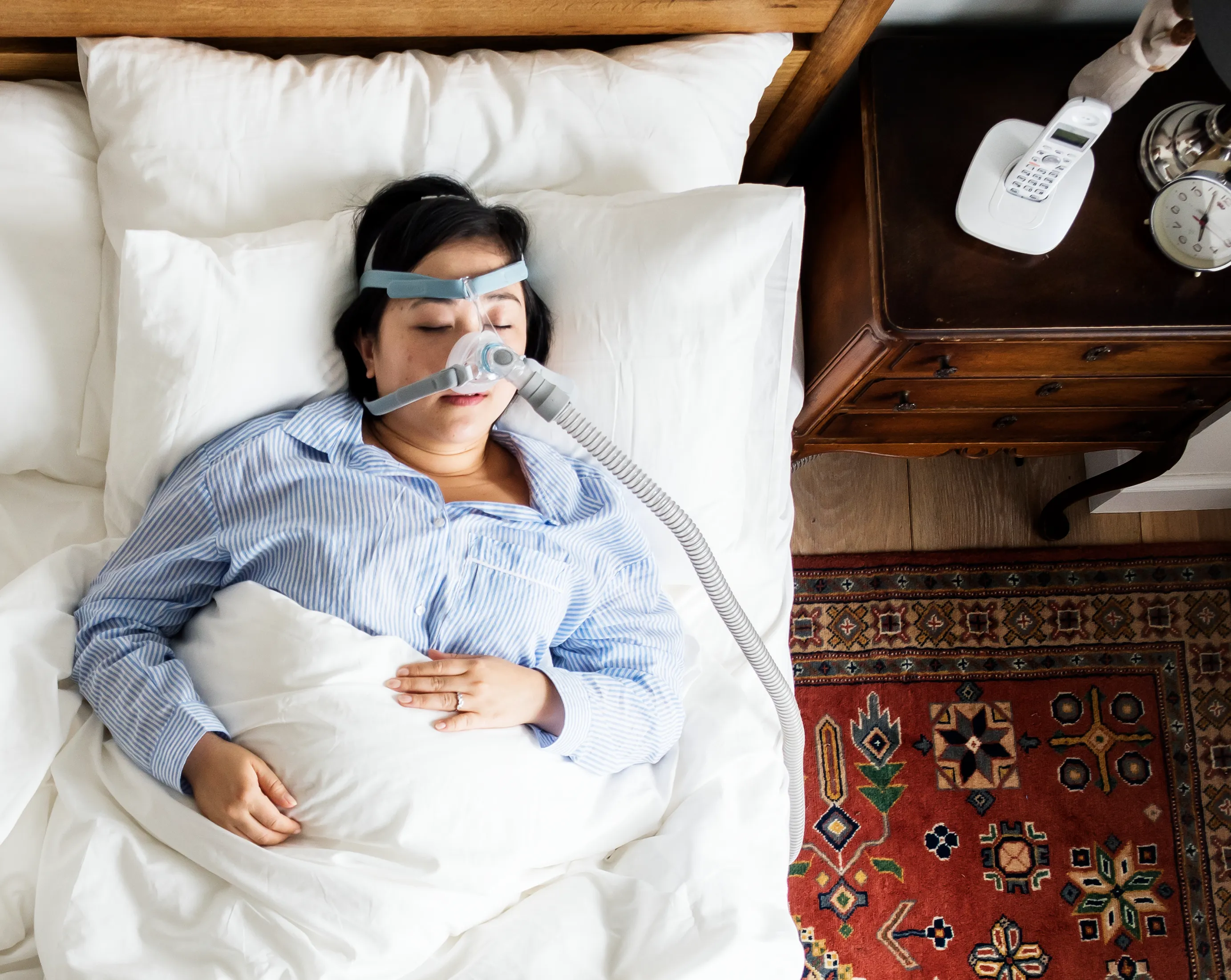Sleep apnea isn’t a one-size-fits-all condition—and neither is its treatment. While many people are familiar with obstructive sleep apnea (OSA), which involves a physical blockage of the airway, other forms like central and complex sleep apnea are more nuanced and less widely understood.
In these cases, the issue isn’t a blocked airway but rather a disruption in the brain’s ability to properly signal the muscles that control breathing. As a result, standard treatments such as Continuous Positive Airway Pressure (CPAP)—which primarily target physical obstructions—may fall short or even prove ineffective.
What is an ASV Machine?
An ASV machine, or Adaptive Servo-Ventilation device, is a non-invasive therapy used to treat certain types of sleep-disordered breathing, especially central sleep apnea.
Unlike traditional CPAP machines, which provide constant pressure, ASV machines adapt in real time to the patient’s breathing patterns. This advanced technology delivers personalized airflow to stabilize breathing throughout the night, which can be further improved if sleeping in the right position.
How an ASV Machine Works
ASV machines monitor each breath you take and respond instantly to irregularities, including shallow breathing or pauses. They provide just enough pressure to support regular respiration without overcompensating.
This dynamic adjustment helps maintain normal breathing rhythm, particularly in patients whose apnea is not due to physical airway blockage.
Key Components of an ASV System
An ASV system typically includes a flow generator, a humidifier, tubing, and a specialized mask that fits over the nose or both the nose and mouth.
The device is equipped with sensors that track the patient’s breathing and adjust airflow on a breath-by-breath basis. Many units also include data tracking to help doctors monitor treatment effectiveness over time.
Who Needs an ASV Machine?
ASV machines are not intended for general snoring or mild sleep issues—they're designed for people who require advanced, adaptive support during sleep.
This type of therapy is typically prescribed when traditional options like CPAP aren't suitable or effective, especially in cases where breathing patterns are irregular or unstable.
Conditions Commonly Treated
Central sleep apnea, often found in people with heart disease or neurological disorders, is the primary condition addressed by ASV.
- Central Sleep Apnea (CSA): CSA is a condition where the brain fails to consistently signal the muscles to breathe, often associated with heart or neurological issues.
- Cheyne-Stokes Respiration: Cheyne-Stokes is a distinctive breathing pattern involving rhythmic changes in breathing depth and speed, frequently seen in people with heart failure.
- Complex or Mixed Sleep Apnea: A combination of obstructive and central sleep apnea symptoms, especially in individuals who don’t respond well to CPAP therapy.
Benefits of Using an ASV Machine for Sleep Apnea

ASV therapy offers more than just relief from snoring—it provides targeted, intelligent support for people with complex sleep apnea conditions.
Adjusting airflow in real time helps restore healthy sleep patterns and prevent complications linked to disrupted breathing. Below are the core benefits users may experience when using an ASV machine consistently.
Improves Sleep Quality

- Reduces Apnea Episodes: ASV machines are highly effective at reducing the number and severity of central apnea episodes throughout the night. By responding to each breath in real time, they ensure more consistent airflow and fewer interruptions in sleep. This leads to longer stretches of undisturbed, restorative rest.
- Enhances Daytime Energy: With fewer apneas and improved sleep quality, individuals often wake up feeling more refreshed and alert. This boost in energy helps improve focus, mood, and overall performance throughout the day. Many patients report a dramatic decrease in fatigue after starting ASV therapy.
- Supports Better Cognitive Function: Chronic sleep apnea can impair memory, attention, and decision-making. By restoring normal breathing patterns and reducing nighttime disruptions, ASV therapy promotes healthy brain function. Over time, patients may notice clearer thinking and improved mental health.
Reduces Health Risks
- Lowers Risk Of Cardiovascular Disease: Untreated central sleep apnea increases the strain on the heart, especially in those with pre-existing cardiovascular conditions. ASV therapy stabilizes breathing and oxygen levels, reducing stress on the heart. This may help lower blood pressure and support long-term heart health.
- Helps Prevent Stroke: Sleep apnea is a known risk factor for stroke due to its effects on blood pressure, oxygen supply, and brain function. ASV helps maintain steady oxygen levels and minimizes the dangerous breathing disruptions that increase stroke risk. For patients with a history of stroke or TIA, ASV can be a protective measure.
- Supports Metabolic Health: Sleep disturbances from apnea can affect glucose regulation, weight control, and hormone balance. By improving sleep continuity, ASV therapy may support healthier metabolism and reduce the risk of conditions like type 2 diabetes. Better sleep also promotes more effective appetite regulation and energy use.
Increases Comfort And Compliance
- Adapts Pressure To Breathing Needs: Unlike standard CPAP, ASV adjusts pressure based on the user’s real-time breathing pattern. This personalized approach avoids over-delivery of air and makes breathing feel more natural. Many patients find ASV to be more comfortable and easier to tolerate long-term.
- Minimizes Therapy Side Effects: Common CPAP side effects like bloating, air leaks, or discomfort from fixed pressure can be minimized with ASV’s adaptive technology. By matching support to actual need, ASV reduces the likelihood of over-pressurization or dryness. This helps improve patient comfort and willingness to continue treatment.
- Encourages Long-Term Usage: Because ASV therapy is more responsive and comfortable, patients are more likely to stick with it consistently. Higher compliance rates lead to better treatment outcomes and fewer complications over time. The easier the therapy is to live with, the greater its long-term benefits.
Key Features To Look For In An ASV Machine
Finding the right ASV machine means understanding which features can deliver both effective therapy and maximum comfort.
Modern devices come with a range of customizable settings and smart technologies designed to improve sleep quality and user experience. Focusing on the right features ensures better treatment outcomes and long-term therapy success.
Pressure Adjustment Range
- Customizable Pressure Support: A quality ASV machine allows precise control over pressure settings to suit your specific breathing patterns. This personalization helps balance comfort with clinical effectiveness. It also accommodates changes in health over time.
- Adapts To Night-Time Breathing Changes: ASV devices are built to respond to variations in breathing from minute to minute. They deliver more or less pressure as needed, keeping your airflow steady throughout the night. This adaptability is especially important for treating central sleep apnea.
Data Tracking And Reporting
- Monitors Therapy Effectiveness: ASV machines record important data, including breathing patterns, leak rates, and apnea events. These insights help both patients and doctors assess the effectiveness of the treatment. Regular reviews of this data can lead to improved outcomes.
- Tracks Sleep Patterns: Many ASV systems connect to apps or desktop software that visualize nightly trends. Users can track hours of use, therapy consistency, and even periods of disrupted sleep. This kind of feedback empowers patients to stay engaged in their treatment.
- Helps Refine Treatment Plans: Shared data allows healthcare providers to make targeted adjustments to pressure settings and machine configurations. This results in therapy that evolves with the patient’s needs. The more data-driven the plan, the more precise and effective the treatment becomes.
Noise Level And Portability
- Quiet Operation For Better Sleep: Low-noise operation is a key feature for many ASV users, especially those who share a bedroom. A quiet machine ensures you and your partner are not disturbed during the night. This encourages regular, long-term use.
- Compact Design For Travel: Portability makes it easier to maintain therapy while traveling. Many modern ASV machines are compact enough for carry-on bags and include international voltage support. You can stay consistent with treatment no matter where you go.
- Lightweight and User-Friendly: Ease of use is critical for long-term success with any sleep therapy device. Lightweight units with intuitive controls make setup and nightly use simple and stress-free. A user-friendly interface also reduces resistance to sticking with therapy.
How To Choose The Right ASV Machine For Your Needs
Selecting the right ASV machine requires a balance between medical necessity and personal comfort. While all ASV devices aim to stabilize breathing, the right fit will depend on your diagnosis, daily habits, and preferences.
With proper guidance and feature evaluation, you can make a choice that supports long-term health and consistent use.
Consult A Healthcare Provider

- Review Medical History: Before choosing a machine, your doctor will assess your complete medical background, including heart and lung health. This ensures that ASV therapy is appropriate and safe for your condition. An accurate diagnosis is the first step toward effective treatment.
- Identify Treatment Goals: Your provider will help you define what success looks like—whether it's reducing apnea events, improving energy, or managing comorbid conditions. Clear goals can influence which machine features matter most. This personalized approach helps you stay focused and compliant.
- Match Machine to Condition Severity: Some ASV models offer more advanced settings or diagnostic tools for complex or severe apnea. Your physician can recommend a device that provides the right level of intervention. Matching machine capabilities to your health status is essential for successful therapy.
Consider Comfort And Mask Fit
- Nasal Masks: These cover the nose and are ideal for users who breathe primarily through their nose at night. They offer a balance between comfort and stability and are commonly used with ASV therapy. However, a proper seal is crucial to prevent air leaks.
- Nasal Pillow Masks: These lightweight options fit directly into the nostrils and are great for users who prefer minimal contact with their face. They allow greater freedom of movement and can feel less restrictive. This option is best for those who don’t require high-pressure support.
- Full-Face Masks: These masks cover both the nose and mouth and are suitable for mouth breathers or those with frequent nasal congestion. They ensure steady airflow but can feel bulkier and may take longer to adjust to. Comfort and a secure fit are essential to prevent pressure leaks.
Evaluate Additional Features
- Adjustable Humidity: Many ASV machines come with built-in humidifiers that allow users to control moisture levels. This helps prevent dryness, irritation, or sore throat caused by airflow. Customizable humidity enhances comfort and encourages nightly use.
- Noise Level: Quiet operation is important for maintaining uninterrupted sleep, especially for users who share a room. Low-decibel machines create a more peaceful sleep environment. Comparing decibel ratings can help you choose a model that won’t disrupt your rest.
- Customer Support Options: Reliable technical support and warranty coverage make it easier to handle malfunctions or troubleshooting. Some manufacturers offer mobile apps, tutorials, and responsive customer service. Good support ensures your therapy continues smoothly without interruptions.
Tips For Getting Used To Your ASV Machine
Adapting to ASV therapy can take time, especially if you're new to sleep-related devices. Developing a routine and making small adjustments to your comfort level can significantly improve long-term success. These practical tips will help ease the transition and make nightly use more manageable.
Gradual Acclimation
- Wear During Daytime Rest: Getting used to the sensation of the mask and airflow during low-stress times like reading or watching TV can reduce anxiety. This helps your brain associate the device with relaxation rather than discomfort. Daytime use also builds familiarity before full overnight sessions.
- Start With Shorter Sessions: Begin by using the machine for short periods and gradually increase the duration over several nights. This staged approach reduces overwhelm and makes it easier to stick with therapy. Consistency is more important than immediate full-night use.
- Familiarize Yourself With Airflow Sensation: The rhythmic airflow of ASV can feel unusual at first, especially the changing pressure. Spending time experiencing the airflow while awake helps you learn how to breathe naturally with the machine. This lowers resistance and boosts confidence.
Optimize Mask Fit
- Adjust Straps: Straps that are too loose may cause air leaks, while overly tight straps can cause pressure marks or discomfort. Fine-tuning the tension ensures both a proper seal and comfort. A well-fitted mask is crucial for effective and quiet therapy.
- Try Different Sizes Or Styles: If the current mask feels uncomfortable, switching to a different size or style may help. Every face is different, and most manufacturers offer several options to suit individual needs. Don’t hesitate to ask your provider for alternatives.
- Eliminate Air Leaks: Leaks not only reduce the effectiveness of therapy but can also disrupt your sleep with noise or airflow to the eyes. Adjusting the mask position or using a different cushion can resolve most minor leaks. Consistent leak-free sealing leads to better therapy results.
Create A Bedtime Routine
- Relaxing Pre-Sleep Rituals: Taking a warm shower, practicing gentle stretches, or drinking herbal tea can signal your body that it’s time for rest. These calming cues help ease the transition to sleep with the ASV machine. A relaxed mind is more likely to tolerate new sensations.
- Calming Activities: Reading, journaling, or listening to soft music before bed can reduce stress and make wearing the mask feel less intrusive. Avoid screens or anything overly stimulating right before bedtime. A peaceful wind-down supports better acceptance of therapy.
- Consistent Sleep Schedule: Going to bed and waking up at the same time each day reinforces your natural circadian rhythm. Routine strengthens your body’s ability to adapt to ASV use and improves overall sleep quality. Over time, your therapy becomes part of your nightly rhythm.
Potential Side Effects And Troubleshooting ASV Machine Issues
While ASV machines offer highly adaptive and effective therapy, some users may experience initial discomfort or technical issues.
Understanding common side effects and knowing how to troubleshoot can help ensure continued comfort and compliance. Recognizing when professional help is needed is also key to long-term treatment success.
Common Side Effects
- Nasal Dryness: Dry air from the machine may cause irritation or dryness in the nasal passages. Using a built-in humidifier or adding a heated tube can help maintain moisture levels. Adjusting humidity settings usually resolves the issue quickly.
- Dry Mouth: Mouth breathing during therapy can lead to a dry mouth feeling upon waking. Switching to a full-face mask or using a chin strap can reduce mouth leakage. Staying hydrated throughout the day also helps prevent this symptom.
- Skin Irritation: Pressure from the mask or friction from straps can lead to redness, soreness, or marks on the face. Trying mask liners or adjusting the fit can alleviate pressure points. Regularly cleaning the mask and rotating mask types can also help.
Troubleshooting Tips
- Check Mask Seal: A poor seal can lead to air leaks, reduced effectiveness, and noise disruption. Repositioning the mask or replacing worn-out cushions can often solve the problem. Ensuring the mask is correctly sized is also essential.
- Adjust Strap Tightness: Straps that are too tight may cause discomfort, while loose straps can compromise the seal. Making small adjustments gradually can help achieve a secure yet comfortable fit. Elastic straps tend to loosen over time and may need replacement.
- Clean Components Regularly: Dust, oils, and moisture buildup can affect machine performance and hygiene. Cleaning the mask, tubing, and humidifier chamber weekly prevents blockages and odor. Always follow manufacturer guidelines for proper maintenance.
When To Seek Help
- Persistent Discomfort: If irritation, dryness, or pressure issues continue despite adjustments, consult your provider. There may be alternative mask styles, settings, or accessories better suited to your needs. Don’t wait too long to address discomfort—it can reduce therapy compliance.
- Ineffective Treatment: If you're still experiencing daytime fatigue or sleep disruptions despite regular use, the machine settings may need to be reviewed. A sleep study or device data analysis can help identify the issue. Modifying pressure ranges or replacing the unit may be required.
- Unresolved Technical Issues: If your machine displays error messages, won’t start, or loses pressure unexpectedly, contact customer support or your supplier. Avoid trying to fix electrical issues on your own. Reliable service and warranties are in place for this reason.
How ASV Differs from CPAP and BiPAP
Before choosing a sleep therapy device, it’s important to understand how different machines function and which conditions they are designed to treat. The table below highlights the key differences between these three technologies to help you make an informed decision.
| Feature | CPAP (Continuous Positive Airway Pressure) | BiPAP (Bilevel Positive Airway Pressure) | ASV (Adaptive Servo-Ventilation) |
|---|---|---|---|
| Airflow Delivery | Delivers constant, fixed pressure | Delivers two fixed pressures: one for inhale, one for exhale | Adjusts pressure breath-by-breath in real time |
| Best For | Obstructive Sleep Apnea (OSA) | OSA with pressure intolerance or certain lung issues | Central Sleep Apnea, Cheyne-Stokes respiration, complex cases |
| Pressure Flexibility | No variation—same pressure throughout the night | Two preset levels: higher inhale, lower exhale | Continuously adapts based on user’s breathing pattern |
| Adaptability | Basic, non-responsive | Somewhat responsive via pressure difference | Highly responsive with real-time automatic adjustments |
| Technology Complexity | Most basic | Moderate | Most advanced |
| Comfort Level | Can feel too forceful or rigid | More comfortable for some due to pressure difference | Most natural and comfortable for central apnea users |
| Data Tracking | Varies by model, often minimal | Often includes basic tracking features | Typically includes advanced data and reporting tools |
| Cost | Most affordable | Mid-range | Most expensive |
FAQs
What is the primary function of an ASV machine?
The primary function of an ASV machine is to manage central sleep apnea by adapting to your breathing patterns and ensuring consistent airflow during sleep.
How does an ASV machine differ from a CPAP machine?
Unlike CPAP machines, which provide a constant airflow, ASV machines dynamically adjust the pressure based on real-time monitoring of your breathing patterns, making them suitable for complex sleep apnea cases.
Are ASV machines covered by insurance?
Coverage for ASV machines varies by insurance provider and policy. It's important to check with your insurance company to determine if the device is covered under your plan.
Can I travel with my ASV machine?
Yes, many ASV machines are designed to be portable and come with travel friendly features. It's advisable to check with airlines for specific travel guidelines.
What maintenance is required for an ASV machine?
Regular maintenance includes cleaning the mask, tubing, and humidifier chamber. Follow the manufacturer's recommendations for maintenance to ensure optimal performance.
Will using an ASV machine eliminate my sleep apnea?
While ASV machines effectively manage sleep apnea symptoms, they do not cure the condition. Continuous use is necessary to maintain benefits.
How long does it take to adjust to an ASV machine?
Adjustment periods vary, but many users acclimate within a few weeks. Consistent use and proper mask fitting can accelerate this process.
What should I do if I experience discomfort with my ASV machine?
If discomfort persists, consult your healthcare provider to adjust machine settings or explore alternative mask options.
Conclusion
Managing sleep apnea effectively starts with the right diagnosis and the right equipment. ASV machines offer dynamic, personalized therapy for those with more complex respiratory patterns, improving both sleep quality and long-term health outcomes.
By understanding the machine’s features, adjusting to it gradually, and staying in close contact with your healthcare provider, you can turn nightly therapy into a sustainable part of your wellness journey.
Karen Barnard
Karen is a Human Movement Science expert and a certified sports nutrition and massage therapist. At Sleepiverse, she combines her passion for human movement science and sleep health to educate herself and her readers about healthier sleep. In addition to writing articles, Karen manages a fitness studio offering private training, athletic conditioning, and sports massage therapy. She focuses on providing people with a holistic environment for people to reach their health goals, often incorporating stretch therapy to promote mental tranquillity and help people improve their sleep.


